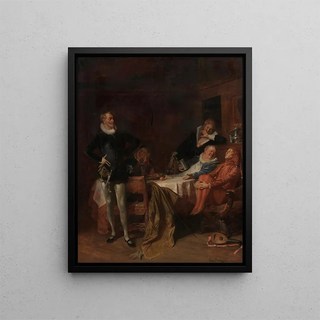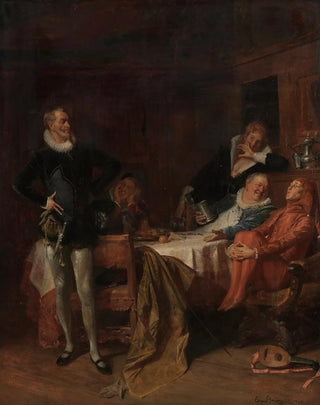Art print | Ce que tu veux - Eduard von Grützner


View from behind

Frame (optional)
What You Want - Eduard von Grützner – Captivating Introduction
In the fascinating universe of art, some works manage to capture the very essence of the human condition while offering a glimpse into the subtleties of everyday life. "What You Want - Eduard von Grützner" falls into this category of artworks that, through their apparent simplicity, reveal an unsuspected depth. This painting, imbued with delicacy and emotion, transports us to a moment of life where the artist succeeds in freezing time while evoking universal feelings. Through this art print, the viewer is invited to explore a world where human desires and aspirations blend with the beauty of daily life, creating a tableau that is both intimate and accessible.
Style and uniqueness of the work
Eduard von Grützner's style is characterized by meticulous attention to detail and a keen sense of composition. In "What You Want," the artist deploys a palette of rich and harmonious colors that capture the light in a masterful way. The characters, portrayed with palpable expressiveness, seem to come to life under the artist's brush. Every stroke, every shadow, is carefully thought out to create a warm and convivial atmosphere. The scene depicted, where the protagonists interact with natural ease, evokes a conviviality that transcends time and space. This work is a true ode to life, where the viewer's gaze is drawn to the details that tell a story, that of desires, exchanges, and shared moments.
The artist and his influence
Eduard von Grützner, born in 1846 in Munich, is an emblematic painter of the realist movement. His career, marked by an incessant quest for truth and authenticity, has profoundly influenced his contemporaries and subsequent generations. Grützner always strived to depict life as it is, far from the idealizations often present in the art of his time. His innovative approach and undeniable talent allowed him to carve out a prominent place in the art world. The themes he explores, often related to daily life and human interactions, continue to inspire

Matte finish

View from behind

Frame (optional)
What You Want - Eduard von Grützner – Captivating Introduction
In the fascinating universe of art, some works manage to capture the very essence of the human condition while offering a glimpse into the subtleties of everyday life. "What You Want - Eduard von Grützner" falls into this category of artworks that, through their apparent simplicity, reveal an unsuspected depth. This painting, imbued with delicacy and emotion, transports us to a moment of life where the artist succeeds in freezing time while evoking universal feelings. Through this art print, the viewer is invited to explore a world where human desires and aspirations blend with the beauty of daily life, creating a tableau that is both intimate and accessible.
Style and uniqueness of the work
Eduard von Grützner's style is characterized by meticulous attention to detail and a keen sense of composition. In "What You Want," the artist deploys a palette of rich and harmonious colors that capture the light in a masterful way. The characters, portrayed with palpable expressiveness, seem to come to life under the artist's brush. Every stroke, every shadow, is carefully thought out to create a warm and convivial atmosphere. The scene depicted, where the protagonists interact with natural ease, evokes a conviviality that transcends time and space. This work is a true ode to life, where the viewer's gaze is drawn to the details that tell a story, that of desires, exchanges, and shared moments.
The artist and his influence
Eduard von Grützner, born in 1846 in Munich, is an emblematic painter of the realist movement. His career, marked by an incessant quest for truth and authenticity, has profoundly influenced his contemporaries and subsequent generations. Grützner always strived to depict life as it is, far from the idealizations often present in the art of his time. His innovative approach and undeniable talent allowed him to carve out a prominent place in the art world. The themes he explores, often related to daily life and human interactions, continue to inspire






